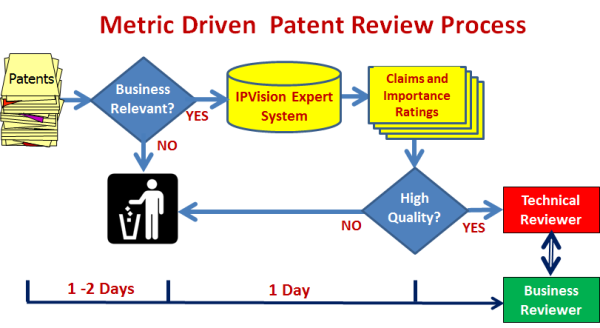In the first article of this series we explored the forces that have given rise to a more active market in Patent Portfolio Trafficking. In summary, increased recognition of the value of intellectual assets, increased ability to analyze and measure IP, the Open Innovation movement and increased Senior Management involvement in IP. In this and the following articles of this series we present real cases (disguised for confidentiality) of how companies are trying to deal with Patent Portfolio Trafficking.

Category: Small Volume Cases – Just Getting Started
In this article we start with the “Small Volume Case”, i.e., a company that has only recently been contacted by an IP broker or has only had to conduct patent evaluations on a small number of patent acquisition portfolios.
Prototypical Situation
The Small Volume Case company has not yet established a formal process for due diligence review of in-bound patent portfolios or the process it has implemented is somewhat ad hoc. What process there is most likely involves patent evaluation by a team of 1 or 2 technical people and a lawyer. This company may or may not have internal intellectual property counsel.
In most cases we have seen, “legal” is the time-constrained resource and as a result the process typically starts with the technical experts reviewing the patents being offered. Usually at this stage the review parameters are (a) whether the company’s existing or planned products might infringe the offered patents and (b) whether the technology described could be useful in the company’s development plans.
If the technical appraisal is that infringement may exist then the legal experts weigh in since the interpretation of patent claims is a legal matter. Even with a small portfolio being presented (e.g., 5 to 10 patents) this process can take 3 to 6 weeks to complete. In becomes extremely difficult and time consuming for larger portfolios – even for portfolios as small as 20 patents. The cost can be significant especially if outside counsel is engaged for the legal review.

We rarely see significant business input in the Small Volume Case company, e.g., asking whether this patent acquisition could bolster the company’s defensive position or otherwise impact the company’s strategy. This is often because there is little “IP Visibility” into the company’s known competitors or the IP side of technical innovations that may already be or may soon be transforming the industry. It is also likely that Management has not yet fully engaged in the business side of IP, i.e., IP is primarily the province of the lawyers.
Attributes of Ad Hoc Review
- Little or No Business Context for Review
- Few, if any, Consistent Metrics Applied
- Little or No Business Review or Visibility
- Time and Resource Consuming and Inefficient/Costly and Slow
- Not Repeatable from one Patent Portfolio to another
- Not Scalable
IPVision's Solution
IPVision has assisted Small Volume Case companies develop more robust, repeatable, timely and cost effective processes for screening even a few portfolios a year. At the core of the processes we have helped design are IPVision patent analytics and in particular Claims Analytics and Patent Importance Ratings. These patent evaluation analytics help prioritize the patents to be reviewed manually and because they are evidence-based and repeatable they make sure that there is consistency in the decision process from portfolio to portfolio.
IPVision Claims Analytics algorithms identify the independent claims of a patent and then parse and analyze the claims text into 40+ “claims attributes” which are used to construct patent quality ratings. A simple example of a claim attribute is the “word count” of the claim – the number of words in the claim. Another example is the occurence of a specific noun phrase and the relative frequency of occurence of a specific noun phrase. IPVision’s Claims Analysis Expert System rates each independent claim for its “broadness” (A is the broadest to C narrow) and its “structure” (1= no evident structure issues to 5= significant issues). The structure rating is important because it helps identify patent enforceability and limitation issues. The Expert System was developed with input from seasoned patent litigation and patent licensing experts and takes into account holdings of court cases.
Our Patent Importance Rating looks at the relative citation frequency of the patent in relation to its peers in time and technology space.
Claims Analytics and Patent Importance Ratings help redesign and streamline the patent evaluation process. The in-bound patent portfolio is quickly reviewed (title and abstracts) to see where it fits in the company’s current and strategic plans. Then Claims Analytics and Ratings are run to determine the patent quality of the offered patents. Legal counsel quickly reviews the results to confirm or adjust the ratings. If the patents have weak claims or are relatively unimportant then the time and cost of technical review can be avoided. If the first pass review is that the portfolio is relevant and the quality ratings are high then the technical experts are brought in for a more in depth review and coordination with Management.

The 3 to 6 weeks Ad Hoc Process has been streamlined to a 1 to 3 Day timeframe and because the results are evidence-based and repeatable there is a more consistent method for educating and involving business decision makers in the process.
Attributes of Metric Driven Process
- Early Triage for Business Relevancy
- Consistent Metrics
- Fast and Efficient
- Scalable
- Enables Business Decision Maker Involvement in IP Strategy
The Metrics just described are on a patent-by-patent basis. In the next installment of this Patent Portfolio Trafficking series we will discuss how some companies are also looking at overall patent portfolio analytics.
Author: Joseph G. Hadzima, Jr. | Senior Lecturer, MIT Sloan School of Management | Co-Founder & President of IPVision, Inc.




